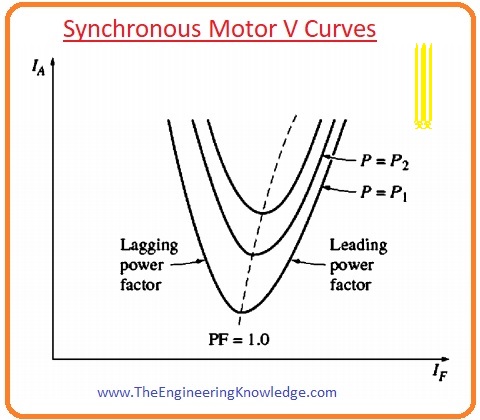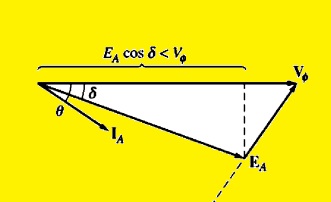 Hello friends, I hope all of you are having fun in your life. In today’s tutorial, we are gonna have a look at Effect of Field Current Changes on a Synchronous Motor. Synchronous motor is such an electrical device in which during operation the revolution of rotor is coherent with the rotation of a rotating field of stator. If the load at the synchronous motor is not varying and its excitation is changing then the P.F will vary spontaneously to maintain its active constituent constant under all excitation variations. The value of IA is constant as the load associated with the motor, its power losses do not vary.
Hello friends, I hope all of you are having fun in your life. In today’s tutorial, we are gonna have a look at Effect of Field Current Changes on a Synchronous Motor. Synchronous motor is such an electrical device in which during operation the revolution of rotor is coherent with the rotation of a rotating field of stator. If the load at the synchronous motor is not varying and its excitation is changing then the P.F will vary spontaneously to maintain its active constituent constant under all excitation variations. The value of IA is constant as the load associated with the motor, its power losses do not vary.
In today’s post, we will have a look at the effect of field current variation on motor operation and related factors. So let’s get started with the Effect of Field Current Changes on a Synchronous Motor.
Effect of Field Current Changes on a Synchronous Motor
- To find the effect of field current variation on synchronous motor we study given below figure.
- First, we suppose that the motor is connected with inductive load (lagging P.F) so if we increase the field current (IF) it effect is drawn in a given figure.
- We observe that with the increment of field current internal generated voltage increases but there is no effect on power provided by the motor.
- The power of motor will vary only when the torque of the load shaft varied.
- So the field current has zero effect of speed of rotation of a shaft, as the load connected with shaft of motor is constant so active power provided by the motor will also remain constant.
- The terminal voltages (VT) are also constant these are maintained by the supply connected with motor.
- The terms EAsins and IAcosø are also constant. With the increment of (IF) internal generated voltage also enhances but there increment is along the line of power. This factor is drawn in given figure.
- The main point you can note from the figure that with the increment of internal generated voltage armature current (IA) firstly lessen than starts to increase.
- At less value of internal generated voltage, IA is lagging and motor behaving like inductive load connected with it.
- Its bevaiour is like a circuit that consists of resistance and inductor that using reactive power Q.
- With the increment of IF, IA will become in line with Vø so motor behaves like a resistive circuitry.
- With the further increment in the IF the IA becomes leading current so now motor behaves like a capacitive load.
- Now it works like such circuitry that has resistance and capacitor and using a negative value of reactive power (-Q), means now motor providing reactive power Q to the connected system.
- In the given figure, the graphical representation between the field current and armature current of a synchronous motor is drawn.
- Such type of arrangements is known as V curve of synchronous motor it so called because its physical structure is like ‘V’.
- In the figure there are many V curves are constructed at different power values.
- For every curve, the least value of IA exits when P.F is one means only active power is delivered to motor.
- But at other points motor getting or provides reactive power to the system.
- At such value of field current that is less the value that provides least value of armature current, the IA lagging means motor using reactive power.
- So we can easily control the reactive power by using a motor or delivered to a connected system by regulating the IF.
- When the projection of phasor diagram of internal generated voltage on Vø is less than the magnitude of Vø now motor behaves like an inductive load and uses reactive power.
- As the value of IF lesser so motor is said to be in an under-excited state.
- If the phasor projection internal generated voltage is larger than Vø now motor is behaving like capacitive load and delivering power (Q) to the system.
- As the value of IF is larger so the motor is said to be in the overexcited state. Given the below diagram explains these 2 factors.
So it is the detailed post on Effect of Field Current Changes on a Synchronous Motor i have explained each and everything related to this topic. If you have any question ask in comments. See you in next tutorial Synchronous Motor Power Correction.
- I also have written some related articles you can also read them are listed here.I
- Introduction to Synchronous Motor
- Synchronous Motor Torque-Speed Characteristic Curve
- Synchronous Motor Starting Method
- What is Synchronous Condenser (Capacitor)
- Synchronous Motor Power Correction.
- Types of Synchronous Motor
- Effect of Field Current Changes on a Synchronous Motor.











When someone writes an article he/she maintains the image of a
user in his/her mind that how a user can know it.
Thus that’s why this article is perfect. Thanks!
thanks
Like!! Great article post.Really thank you! Really Cool.